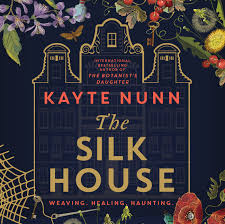The new novel by author Kayte Nunn is The Silk House (Hachette 2020), a gothic, haunting and thrilling tale of an English residence and some who have lived there over its 150-year history. Reminiscent of the novels by Kate Morton, The Silk House follows the lives of three different women in different times, all connected to the one old house, as the story explores the subjects of weaving, textiles, archaeology and history, botany, witchcraft, herbalism, mothering, apothecary and ghosts, and the themes of haunting, loss, ambition and superstition. The story features strong female characters unafraid to test the boundaries of their times and determined to uncover the truth that evades them.
This mystery, set in a small British town, takes place in an imposing structure that was once a fabric shop and family home in the late 1700’s, and has gone through many iterations since, but is now a fusty and traditional school boarding house. Thea Rust, an Australian history teacher, has accepted a job with the prestigious Oxleigh College, a solid stone building thick with ivy, arches and heavy oak doors and iron gates. The College was exclusively for boys, but this year is the first intake of girls, and Thea finds she is to be temporarily responsible, as housemistress, for the first group of 14 girls. Her father attended school at Oxleigh College and the many buildings it comprises have a long and troubled past. As Thea settles in, unsettling and disturbing behaviour from other members of staff rattle her, and inexplicable happenings in the house itself do nothing to quell her nerves.
The dual timeline in the story, set in the late 1700’s, concerns Rowan Caswell, a young servant girl who has left her quiet village to find work at the home of a wealthy patron. Employed at The Silk House, she is soon sought after for her knowledge of herbs and healing, attention that she tries to deflect because she is (rightly) afraid of being associated with witchcraft. Rowan is a young woman with few choices and even fewer rights, and her growth throughout the story as she gains confidence is well-drawn and empathetic.
At the same time, we are introduced to Mary-Louise Stephenson, a financially struggling spinster living with her sister and trying to make a living in the weaving trade. A woman ahead of her time, Mary-Louise dreams of becoming a famous designer of silk patterns to be woven by craftspeople onto fine material to be made into dresses for high society patrons. But designing is the realm of men (as were so many professions and trades at that time), and when Mary-Louise begins experimenting with patterns woven with deadly and poisonous plants, she cannot foresee the consequences for those who live in The Silk House.
Inspired by a real house known by the author, The Silk House is a mysterious and puzzling story that moves seamlessly between the past and the present, weaving together the lives of these three women as each of them attempts to find their place and to achieve their dreams. The evocation of the 1700’s is authenticated by rich sensory descriptions informed by significant research. The supernatural elements of the story are especially interesting when comparing the two time periods – how characters react to unnatural or creepy occurrences in 1768 is vastly different to the way characters relate to strange phenomenon in 2019, and yet still there remains a commonality of distrust, fear, suspicion and distaste. This is an easy-to-read, atmospheric novel that rests lightly on its historical scaffolding while incorporating modern dilemmas, and will appeal to readers of Lauren Chater, Melissa Ashley and Kate Morton.

